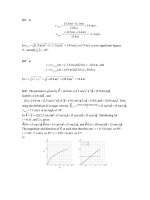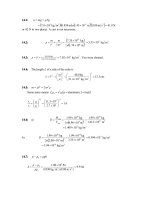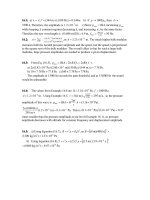- Trang chủ >>
- Khoa Học Tự Nhiên >>
- Vật lý
Tài liệu Physics exercises_solution: Chapter 08 doc
Bạn đang xem bản rút gọn của tài liệu. Xem và tải ngay bản đầy đủ của tài liệu tại đây (349.1 KB, 42 trang )
8.1: a)
s.mkg1020.1)smkg)(12.0000,10(
5
b) (i) Five times the speed,
s.m0.60
(ii)
5
s.m8.26sm0.12
8.2: See Exercise 8.3 (a); the iceboats have the same kinetic energy, so the boat with the
larger mass has the larger magnitude of momentum by a factor of
.2)()2( mm
8.3: a)
.
2
1
2
1
2
1
222
2
m
p
m
vm
mvK
b) From the result of part (a), for the same kinetic energy,
2
2
2
1
2
1
m
p
m
p
, so the larger mass
baseball has the greater momentum;
.525.0145.0040.0
ballbird
pp
From the result
of part (b), for the same momentum
2211
mKmK
, so
2211
wKwK
; the woman, with the
smaller weight, has the larger kinetic energy.
.643.0700450
womanman
KK
8.4: From Eq. (8.2),
smkg1.7820.0cossm50.4kg420.0
xx
mvp
s.mkg0.64620.0sin sm50.4kg420.0
yy
mvp
8.5: The y-component of the total momentum is
s.mkg256.0sm80.7kg0570.0sm30.1kg145.0
This quantity is negative, so the total momentum of the system is in the
y
-direction.
8.6: From Eq. (8.2),
s,mkg015.1sm00.7kg145.0
y
p
and
s,mkg405.0sm00.9kg045.0
x
p
so the total momentum has magnitude
s,mkg09.1smkg015.1smkg405.0
22
22
yx
ppp
and is at an angle arctan
68
405.
015.1
, using the value of the arctangent function in the
fourth quadrant
.0p,0
y
x
p
8.7:
N.563
s1000.2
sm0.25kg0450.0
3
t
p
The weight of the ball is less than half a newton, so the
weight is not significant while the ball and club are in contact.
8.8: a) The magnitude of the velocity has changed by
s,m0.100sm0.55sm0.45
and so the magnitude of the change of momentum
is
s,mkg14.500)sm0.100(kg)145.0(
to three figures. This is also the magnitude of
the impulse. b) From Eq. (8.8), the magnitude of the average applied force is
s1000.2
kg.m/s500.14
3
=7.25
N.10
3
8.9: a) Considering the +x-components,
,smkg73.1s)05.0(N)0.25(s)m00.3kg)(16.0(
12
Jpp
and the velocity is
10.8
sm
in the +x-direction. b) p
2
= 0.48
smkg
+ (–12.0 N)(0.05 s) = –0.12
smkg
, and the velocity is +0.75
sm
in the –x-direction.
8.10: a)
F
t=(1.04
j
)smkg10
5
. b) (1.04
j
ˆ
)smkg10
5
.
c)
.jj
ˆ
)sm10.1(
ˆ
kg)000,95(
)kg.1004.1(
s
m
5
d) The initial velocity of the shuttle is not known; the
change in the square of the speed is not the square of the change of the speed.
8.11: a) With
,0
1
t
,)sN1000.2()sN1080.0(
3
2
292
2
7
0
2
ttdtFJ
t
xx
which is 18.8
smkg
, and so the impulse delivered between t=0 and
.i
ˆ
)smkg(18.8iss1050.2
3
2
t
b)
ands),1050.2()sm(9.80kg)145.0(
3
2
y
J
the impulse is
j
ˆ
)smkg1055.3(
3
c)
2
t
J
x
=7.52
N,10
3
so the average force is
(7.52
.i
ˆ
N)10
3
d)
jpp
12
)
ˆ
1055.3
ˆ
(18.8m/s)
ˆ
0.5
ˆ
kg)(40.0145.0(
3
jiji
.ji
ˆ
kg.m/s)73.0(
ˆ
kg.m/s)0.13(
The velocity is the momentum divided by the mass, or (89.7 m/s)
.ji
ˆ
m/s)0.5(
ˆ
8.12: The change in the ball’s momentum in the x-direction (taken to be
positive to the right) is
m/s,kg15.41m/s)0.5030coss)m0.65((kg)145.0(
so the x-
component of the average force is
N,108.81
s1075.1
m/skg41.15
3
3
and the y-component of the force is
N.107.2
s)1075.1(
30sin m/s)kg)(65.0145.0(
3
3
8.13: a)
2
1
),(
3
)(
3
1
3
212
t
t
tt
B
ttAFdtJ
or
.0 tif)3/(
1
3
22
tBAtJ
b)
.
3
3
22
t
m
B
t
m
A
m
J
m
p
v
8.14: The impluse imparted to the player is opposite in direction but of
the same magnitude as that imparted to the puck, so the player’s speed is
cm/s,27.4
kg)0.75(
)sm(20.0kg)16.0(
in the direction opposite to the puck’s.
8.15: a) You and the snowball now share the momentum of the snowball
when thrown so your speed is
s.cm68.5
kg)0.400kg(70.0
s)m(10.0kg)400.0(
b) The change in
the snowball’s momentum is
s),mkg20.7)sm0.18()kg400.0(
so
your speed is
cm/s.3.10
kg70.0
smkg20.7
8.16: a) The final momentum is
s,mkg1975.0)sm650.0)(350.0()sm120.0)(kg250.0(
taking positive directions to the right. a) Before the collision, puck B was
at rest, so all of the momentum is due to puck A’s motion, and
m/s.790.0
kg250.0
m/skg5197.0
1
A
A
m
p
v
b)
2
1
2
2
2
212
2
1
2
1
2
1
AABBAA
vmvmvmKKK
2
22
)sm7900.0)(kg250.0(
2
1
)sm650.0)(kg350.0(
2
1
)sm0.120()kg250.0(
2
1
J0023.0
8.17: The change in velocity is the negative of the change in Gretzky’s
momentum, divided by the defender’s mass, or
s.m66.4
)sm0.13sm50.1(
N900
N756
sm00.5
)(
1212
AA
B
A
BB
vv
m
m
vv
Positive velocities are in Gretzky’s original direction of motion, so the
defender has changed direction.
b)
)(
2
1
)(
2
1
2
1
2
2
2
1
2
212
BBBAAA
vvmvvmKK
)m/s)5.00(m/s)N)((4.66090(
)m/s)0.13(m/s)N)((1.50675(
)m/s08.9(2
1
22
22
2
kJ.85.6
8.18: Take the direction of the bullet’s motion to be the positive direction. The total
momentum of the bullet, rifle, and gas must be zero, so
,0m/s)1.85kg)((2.80m/s)1.85m/skg)(60100072.0(
gas
p
and
gas
p
= 0.866
.smkg
Note that the speed of the bullet is found by subtracting
the speed of the rifle from the speed of the bullet relative to the rifle.
8.19: a) See Exercise 8.21;
.sm3.60)sm080.0(
kg00.1
kg00.3
A
v
b)
J.46.8m/s)kg)(1.20000.3)(2/1(m/s)(3.60kg)(1.002)1(
22
8.20: In the absence of friction, the horizontal component of the hat-plus-adversary
system is conserved, and the recoil speed is
.sm66.0
kg)012(
36.9cos)smkg)(22.005.4(
8.21: a) Taking
A
v
and
B
v
to be magnitudes, conservation of momentum is
expressed as
BBAA
vmvm
, so
.
A
B
A
B
v
m
m
v
b)
.
))/(()2/1(
)2/1(
2
2
2
2
A
B
ABAB
AA
BB
AA
B
A
m
m
vmmm
vm
vm
vm
K
K
(This result may be obtained using the result of Exercise 8.3.)
8.22:
XPo: decay Po
2104214214
m/s101.92
kg1065.6
J)102(1.23
2
2
1
:
7
27
12
2
m
KE
v
vmKESetv
Momentum conservation:
m/s1065.3
kg)1067.1)(210(
m/s)10kg)(1.921065.6(
210
0
5
27
727
p
xx
m
vm
m
vm
v
vmvm
x
x
8.23: Let the +x-direction be horizontal, along the direction the rock is thrown.
There is no net horizontal force, so
x
P
is constant. Let object A be you and object B
be the rock.
35.0cos0
BBAA
vmvm
m/s11.2
0.35cos
A
BB
A
m
vm
v
8.24: Let Rebecca’s original direction of motion be the x-direction. a) From
conservation of the x-component of momentum,
,kg)0.65(53.1m/s)coskg)(8.0(45.0m/s)kg)(13.00.45(
x
v
So
s.m67.5
x
v
If Rebecca’s final motion is taken to have a positive
-y
component, then
s.m43.4
kg)0.65(
53.1sin s)mkg)(8.00.45(
y
v
Daniel’s final speed is
22
yx
vv
s,m20.7s)m43.4(s)m67.5(
22
and his direction is arctan
38
67.5
42.4
from the
-x
axis, which is
1.91
from the
direction of Rebecca’s final motion.
b)
222
s)m(13.0(45.0)
2
1
)sm(7.195kg)0.65(
2
1
s)m(8.0kg)0.45(
2
1
K
J.680
Note that an extra figure was kept in the intermediate calculation.
8.25:
s),m25.2()sm00.4()sm00.3)((
KenKimKenKim
mmmm
so
,750.0
s)m00.3()sm00.4(
s)m25.2(s)m00.3(
Ken
Kim
m
m
and Kim weighs
N.525N)700)(750.0(
8.26: The original momentum is
s,mkg1060.9)sm00.4)(kg000,24(
4
the
final mass is
kg,000,27kg3000kg000,24
and so the final speed is
s.m56.3
kg1070.2
smkg1060.9
4
4
8.27: Denote the final speeds as
BA
vv and
and the initial speed of puck A as
,
0
v
and
omit the common mass. Then, the condition for conservation of momentum is
0.45cos0.30cos
0 BA
vvv
.0.45sin0.30sin0
BA
vv
The
0.45
angle simplifies the algebra, in that sin
,0.45cos0.45
and so the
B
v
terms cancel when the equations are added, giving
sm3.29
0.30sin0.30cos
0
v
v
A
From the second equation,
s.m7.20
2
A
v
B
v
b) Again neglecting the common mass,
,804.0
s)m0.40(
s)m20.7(s)m3.29(
)21(
))(21(K
2
22
2
0
22
1
2
v
vv
K
BA
so 19.6% of the original energy is dissipated.
8.28: a) From
.,)(
21
2211
21212211
mm
vmvm
vvmmvmvmvmvm
Taking positive
velocities to the right,
sm.3.00
1
v
and
sm1.20
2
v
, so
sm1.60v
.
b)
2
)sm60.1)(kg0.250kg0.500(
2
1
K
22
)sm20.1)(kg0.250(
2
1
)sm3.00)(kg0.500(
2
1
J.1.47
8.29: For the truck,
kg,6320M
and
s,m10V
for the car,
kg1050m
and
sm15v
(the negative sign indicates a westbound direction).
a) Conservation of momentum requires
mvMVvmM
)(
, or
eastbound.sm4.6
kg)1050kg6320(
)sm15)(kg1050()sm10)(kg6320(
v
b)
.sm5.2
kg6320
)sm15kg)(1050(
M
mv
V
c)
kJ281KE
for part (a) and
kJ138KE
for part (b).
s.m1.3
)kg195(
)sm2.7)(kg85(
sm0.5
)kg195(
)sm8.8)(kg110(
y
x
v
v
8.30: Take north to be the x-direction and east to be the y-direction (these choices are
arbitrary). Then, the final momentum is the same as the intial momentum (for a
sufficiently muddy field), and the velocity components are
The magnitude of the velocity is then
,sm9.5)sm1.3()sm0.5(
22
at an angle or
arctan
32
0.5
1.3
east of north.
8.31: Use conservation of the horizontal component of momentum to find the velocity of
the combined object after the collision. Let +x be south.
P
x
is constant gives
J0300.0
J0020.0)s100.0)(kg400.0(
J0320.0)s600.0)(kg150.0()s200.0)(kg250.0(
north),scm10.0(scm0.10
)kg400.0()s600.0)(kg150.0()sm200.0)(kg250.0(
12
2
2
1
2
2
2
1
2
2
1
1
22
2
KKK
K
K
vv
v
x
x
Kinetic energy is converted to thermal energy due to work done by
nonconservative forces during the collision.
8.32: (a) Momentum conservation tells us that both cars have the same change in
momentum, but the smaller car has a greater velocity change because it has a smaller
mass.
(b) The occupants of the small car experience 2.5 times the velocity change of
those in the large car, so they also experience 2.5 times the acceleration. Therefore they
feel 2.5 times the force, which causes whiplash and other serious injuries.
car)(largeV2.5
kg1200
kg3000
car)(largecar)(small
V
V
m
M
v
vmVM
8.33: Take east to be the x-direction and north to be the y-direction (again, these choices
are arbitrary). The components of the common velocity after the collision are
h.km33.33
kg)4200(
)hkm0.50(kg)2800(
hkm67.11
kg)4200(
)hkm 35.0(kg)1400(
y
v
v
x
The velocity has magnitude
hkm3.35h)km33.33(h)km67.11(
22
and is at a
direction arctan
7.70
67.11
33.33
south of west.
8.34: The initial momentum of the car must be the x-component of the final momentum
as the truck had no intial x-component of momentum, so
car
truckcar
car
car
cos)(
m
vmm
m
p
v
x
)2490(cos)sm0.16(
kg950
kg2850
.m5.19 s
Similarly,
s.m9.2166sin s)m0.16(
1900
2850
truck
v
8.35: The speed of the block immediately after being struck by the bullet may be found
from either force or energy considerations. Either way, the distance s is related to the
speed
block
v
by
gs.2
k
2
μv
The speed of the bullet is then
s,m229
m)230.0)(m80.9)(20.0(2
kg1000.5
kg205.1
gs2
2
3
k
bullet
bulletblock
bullet
s
m
mm
v
or
sm103.2
2
to two places.
8.36: a) The final speed of the bullet-block combination is
Energy is conserved after the collision, so
2
2
1
)()( VMmgyMm
, and
cm.2.93m0293.0
)sm80.9(
)sm758.0(
2
1
2
1
2
22
g
V
y
J.73.1)smkg)(0.758012.6( a),part Fromc)
J.866)smkg)(380100.12(b)
2
2
1
2
23
2
1
2
2
1
1
K
mvK
s.m758.0)sm 380(
kg012.6
kg100.12
3
V
8.37: Let +y be north and +x be south. Let
A11
vand
S
v
be the speeds of Sam and of
Abigail before the collision.
s.m00.9s,m00.6kg,0.50kg,0.80
22
ASAS
vvmm
x
P
is constant gives
J640
J3465
J4101b)
(Abigail)sm26.2
0.23sin 0.37sin
givesconstant is
(Sam)sm67.9
0.23cos0.37cos
12
2
2
2
1
2
2
2
1
2
2
1
2
1
2
1
2
1
1
1
221
1
221
KKK
vmvmK
vmvmK
v
vmvmvm
P
v
vmvmvm
AASS
AASS
A
AASSAA
y
S
AASSSS
8.38: (a) At maximum compression of the spring,
.
102
Vvv
Momentum conservation
gives
Vkg)0.12(s)m 00.2kg)(00.2(
sm333.0V
spr
2
102
2
02
)(
2
1
2
1
:onconservatiEnergy
UVmmvm
spr
22
)m333.0)(kg0.12(
2
1
s)m00.2)(kg00.2(
2
1
Us
J33.3
spr
U
(b) The collision is elastic and Eqs. (8.24) and (8.25) may be used:
sm67.0 s,m33.1
102
vv
8.39: In the notation of Example 8.10, with the smaller glider denoted as A, conservation
of momentum gives
s.m40.5)00.3()50.1(
22
BA
vv
The relative velocity has
switched direction, so
s.m00.3
22
BA
vv
Multiplying the second of these relations
by (3.00) and adding to the first gives
,sm20.3or s,m4.14)50.4(
22
AA
vv
with
the minus sign indicating a velocity to the left. This may be substituted into either relation
to obtain
s;m20.0
2
B
v
or, multiplying the second relation by (1.50) and subtracting
from the first gives
s,m90.0)50.4(
2
B
v
which is the same result.
8.40: a) In the notation of Example 8.10, with the large marble (originally moving to the
right) denoted as
s.m200.0)00.1()00.3(,
22
BA
vvA
The relative velocity has switched
direction, so
.m600.0
22
svv
BA
Adding these eliminates
2B
v
to give
s,m100.0or s,m400.0)00.4(
22
AA
vv
with the minus sign indicating a final
velocity to the left. This may be substituted into either of the two relations to obtain
s;m500.0
2
B
v
or, the second of the above relations may be multiplied by 3.00 and
subtracted from the first to give
s,m00.2)00.4(
2
B
v
the same result.
.105.4,105.4c)
smkg009.0s,mkg009.0b)
44
BA
BA
KK
PP
Because the collision is elastic, the numbers have the same magnitude.
8.41: Algebraically,
s.m20
2
B
v
This substitution and the cancellation of common
factors and units allow the equations in
and
β
to be reduced to
.sin 1.8sin 0
cos8.1cos2
β
β
Solving for cos
and sin
, squaring and adding gives
.1sin .8.1cos8.12
22
β
Minor algebra leads to cos
.57.26or ,
8.1
2.1
ββ
Substitution of this result into the first
of the above relations gives
.87.36and,cos
5
4
8.42: a) Using Eq.
.),24.8(
3
1
u2u1
u2u1
V
v
A
b) The kinetic energy is proportional to the
square of the speed, so
9
1
K
K
A
c) The magnitude of the speed is reduced by a factor of
3
1
after each collision, so after N collisions, the speed is
N
3
1
of its original value. To find
N, consider
.10
)3ln(
)000,59ln(
)000,59ln()3ln(
000,593
or
000,59
1
3
1
N
N
N
N
to the nearest integer. Of course, using the logarithm in any base gives the same result.
8.43: a) In Eq. (8.24), let
.and Mmmm
BA
Solving for M gives
A
A
vv
vv
mM
In this case,
s,m1020.1ands,m1050.1
77
A
vv
with the minus sign indicating
a rebound. Then,
.9
)20.1)1.50
1.2050.1
mmM
Either Eq. (8.25) may be used to find
s,m1000.3
6
5
v
B
v
or Eq. (8.23), which gives
s),m1020.1(s)m1050.1(
77
B
v
the same result.
8.44: From Eq. (8.28),
m.056.0
)kg90.0(
)m60.0)(kg20.0()m40.0)(kg40.0()m30.0)(kg30.0(
m,044.0
)kg90.0(
)m30.0)(kg20.0()m10.0)(kg40.0()m200kg)30.0(
cm
cm
y
.(
x
8.45: Measured from the center of the sun,
m.1042.7
kg1090.1kg1099.1
)m1078.7)(kg1090.1()0)(kg1099.1(
8
2730
112730
The center of mass of the system lies outside the sun.
8.46: a) Measured from the rear car, the position of the center of mass is, from Eq. (8.28),
m,0.24
kg)1800kg1200(
)m0.40)(kg1800(
which is 16.0 m behind the leading car.
s.m8.16
)kg1800kg1200(
)sm0.20)(kg1800()sm0.12)(kg1200(
(8.30),Eq.Fromc)
s.mkg1004.5)sm0.20)(kg1800()sm0.12)(kg1200(b)
cm
4
v
s.mkg1004.5)sm8.16)(kg1800kg1200(d)
4
8.47: a) With
0
1
x
in Eq. (8.28),
kg.30.0)1)mm)/(2.00.8)((kg10.0()1)/((
cm221
xxmm
.
ˆ
)smkg0.2(
ˆ
)sm0.5)(kg400(b)
iivP .M
cm
c) In Eq. (8.32),
.
ˆ
)sm7.6()kg30.0/(so,
12
iPvv
0
8.48: As in Example 8.15, the center of mass remains at rest, so there is zero net
momentum, and the magnitudes of the speeds are related by
,
2211
vmvm
or
s.m47.0)sm70.0)(kg0.90/kg0.60()/(
1212
vmmv
8.49: See Exercise 8.47(a); with
,0
1
y
Eq. (8.28) gives
)1)/((
cm221
yymm
kg,75.0)1)m4.2/()m0.6)((kg50.0(
so the total mass of the system is 1.25 kg.
b)
.t
dt
d
iva
ˆ
)sm1.50(
3
cmcm
c)
.
ˆ
)N 63.5(
ˆ
s)(3.0)sm50.1()kg1.25(
3
cm
iiaF
m
8.50:
.0so,0
z
F
z
p
The
x
-component of force is
.)sN50.1( t
dt
dp
F
x
x
N25.0
dt
dp
F
y
y
8.51: a) From Eq. (8.38),
N. 0.80)skg0500.0)(sm1600( F
b) The absence of
atmosphere would not prevent the rocket from operating. The rocket could be steered by
ejecting the fuel in a direction with a component perpendicular to the rocket’s velocity,
and braked by ejecting in a direction parallel (as opposed to antiparallel) to the rocket’s
velocity.
8.52: It turns out to be more convenient to do part (b) first; the thrust is the force that
accelerates the astronaut and MMU,
N. 22.5)smkg)(0.029110kg70(
2
maF
a) Solving Eq. (8.38) for
dm
,
gm.53
sm490
s)N)(5.022.5(
ex
v
dtF
dm
8.53: Solving for the magnitude of
dm
in Eq. (8.39),
kg.75.0s)1(
s)m2000(
)smkg)(25.06000(
2
ex
dt
v
ma
dm
8.54: Solving Eq. (8.34) for
ex
v
and taking the magnitude to find the exhaust speed,
dtdm
m
ex
av
2
sm0.15
s.km4.2s160
In this form, the quantity
dtdm
m
is
approximated by
t
m
m
tm
m
160 s.
8.55: a) The average thrust is the impulse divided by the time, so the ratio of the average
thrust to the maximum thrust is
.442.0
s)(1.70N)(13.3
s)N0.10(
b) Using the average force in Eq.
(8.38),
s.m800
kg0125.0
sN0.10
ex
dm
dtF
v
c) Using the result of part (b) in Eq. (8.40),
sm530)0133.00258.0(ln)sm800( v
.
8.56: Solving Eq. (8.4) for the ratio
m
m
0
, with
0
0
v
,
.1.45
skm10.2
skm00.8
expexp
ex
0
v
v
m
m
8.57: Solving Eq. (8.40) for
o
m
m
, the fraction of the original rocket mass that is not fuel,
.exp
ex0
v
v
m
m
a) For
.102.7s))m(2000sm1000.3(exp(,sm1000.31000.1
66553
cv
b)
.22.0s))m2000(s)m3000(exp(,sm3000For v









